Apr 19
Posted: under photography, Plantlife, Wildlife.
Tags: Animal behavior, beauty, native plants, photography, snake April 19th, 2009
Plains Nipple Cactus, Coryphanta missouriensis, is a small, inconspicuous ground-hugging cactus that almost disappears (shrinks a lot) after between flowerings. Unless you know where you have a patch, you do not see it then. But when it flowers, it opens elegant little flowers with long, pointed petals. The lacy pattern of the spines on the […] [...more]
Plains Nipple Cactus, Coryphanta missouriensis, is a small, inconspicuous ground-hugging cactus that almost disappears (shrinks a lot) after between flowerings. Unless you know where you have a patch, you do not see it then. But when it flowers, it opens elegant little flowers with long, pointed petals. The lacy pattern of the spines on the plant, and the starry shape of the flowers, makes this one of the spring joys around here.
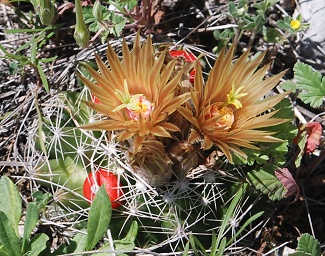
Read the rest of this entry »

Apr 15
Posted: under photography, Plantlife.
Tags: beauty, native plants, photography April 15th, 2009
Despite the way their roots attack the pumps, we plant water iris in the larger permanent water features: they offer desirable habitat for odonates above water, and shelter for tadpoles, red-lined ribbon snakes, and other aquatic critters below the water surface. And though the “land” iris isn’t native here, I enjoy the older varieties that […] [...more]
Despite the way their roots attack the pumps, we plant water iris in the larger permanent water features: they offer desirable habitat for odonates above water, and shelter for tadpoles, red-lined ribbon snakes, and other aquatic critters below the water surface. And though the “land” iris isn’t native here, I enjoy the older varieties that still mark out house-sites and yards in fields where a homesteader’s house has long vanished.
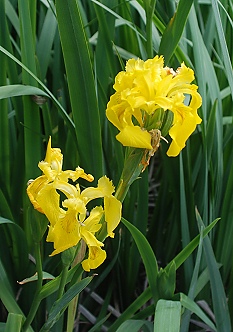
This robust yellow water iris multiples quickly and once more we need to yank about half of it out of the big pond–but it’s attracted hummingbirds and butterflies as well as the odes that perch on it and (some of them) use the stems to lay their eggs in.
Read the rest of this entry »

Apr 05
Posted: under photography, Plantlife, Wildlife.
Tags: beauty, observation, photography April 5th, 2009
Though our prickly pear cactus has been hit by a disease or parasite, as well as the drought, a beautiful lace cactus, Echinocereus reichenbachii, that a rancher lady gave me off her place is thriving. They used to be common on the gravelly-rocky hills around here, but they’re salable and have been pirated off some […] [...more]
Though our prickly pear cactus has been hit by a disease or parasite, as well as the drought, a beautiful lace cactus, Echinocereus reichenbachii, that a rancher lady gave me off her place is thriving. They used to be common on the gravelly-rocky hills around here, but they’re salable and have been pirated off some slopes where I used to see them every spring.
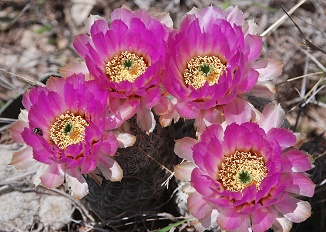 Read the rest of this entry »
Read the rest of this entry »

Mar 31
Posted: under photography, Wildlife.
Tags: beauty, butterflies, photography, wildlife management March 31st, 2009
Monarchs come through central Texas in both the spring and fall migrations. In spring, they particularly need wild milkweeds on which to lay eggs, but they also need flowers that provide nectar, in case they must fly farther to find the milkweeds (and this year, that’s important. Because of drought, the milkweed abundance is way […] [...more]
Monarchs come through central Texas in both the spring and fall migrations. In spring, they particularly need wild milkweeds on which to lay eggs, but they also need flowers that provide nectar, in case they must fly farther to find the milkweeds (and this year, that’s important. Because of drought, the milkweed abundance is way down on our place.)
I usually see monarchs mating while perched on Ashe junipers–as wind protection–and nectaring on whatever’s blooming. Some years, they have a choice. This year, because of the drought, not much choice. The reliable woody shrubs bloom even when the flowering forbs are scarce. Rusty blackhaw viburnum and wild plum (both the Mexican plum and the thicketing plum) provided monarch feeding stations this year.
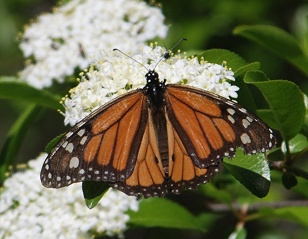
This particular viburnum overhangs the creekbed (now dry) and is at least twenty feet tall. Sunday it was covered with white flower clusters. Since we’ve owned the place, excluding livestock from the creek woods has allowed the growth of new viburnums, so in another ten to twenty years, we should have a lot of flowering shrubs–and some very happy monarchs.
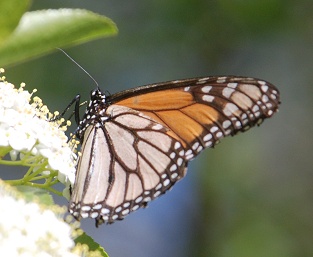
Read the rest of this entry »

Mar 22
Posted: under photography, Plantlife.
Tags: beauty, native plants, photography March 22nd, 2009
Spring has leapt forward this week. On the way to church in the city, I saw drifts of bluebonnets…but the following pictures are from our place, taken in the last day or so. They’re small and scattered, but beautiful–and very popular with the local small wildlife (insects, for instance.) I haven’t had time yet to […] [...more]
Spring has leapt forward this week. On the way to church in the city, I saw drifts of bluebonnets…but the following pictures are from our place, taken in the last day or so. They’re small and scattered, but beautiful–and very popular with the local small wildlife (insects, for instance.)
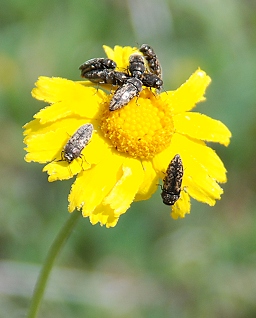
I haven’t had time yet to look up which eager little eaters these are.
Read the rest of this entry »

Mar 18
Posted: under photography, Wildlife.
Tags: Animal behavior, observation, odonates, photography March 18th, 2009
The first odes of spring showed up after the rain, not surprisingly: the first was a tiny Citrine Forktail male seen flying from one (too brief to grab a shot) perch on dead week stalks sticking out of water, late Sunday. On Tuesday evening, behind the #3 gabion, I spotted three pairs of Plateau Spreadwings*, […] [...more]
The first odes of spring showed up after the rain, not surprisingly: the first was a tiny Citrine Forktail male seen flying from one (too brief to grab a shot) perch on dead week stalks sticking out of water, late Sunday. On Tuesday evening, behind the #3 gabion, I spotted three pairs of Plateau Spreadwings*, Lestes alacer, all trying to oviposit on one tiny clump of Eleocharis…the only clump that had greened up.
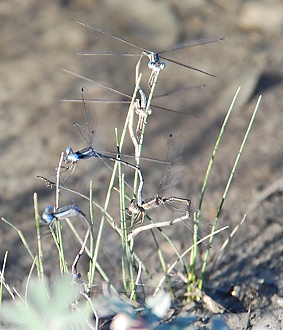
Spreadwing Damselflies ovipositing
The third female is out of sight behind that blurred leaf at the bottom (you can just see one eye and a few segments of abdomen.) The males have bright blue eyes and a pale blue or pale green stripe on the thorax; the females are shades of brown/tan/beige.
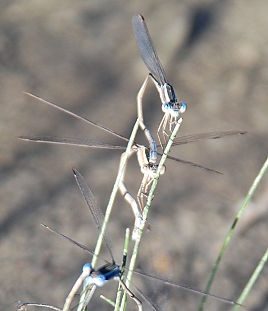
The male holds on while the female makes a slit in the stem of the plant and inserts eggs. These stems are so thin it’s hard to imagine any room for eggs inside, but after the long drought, no water plants with thicker stems had emerged from last week’s rain. Only this single little clump. Unfortunately, we’re not expecting any rain, and it’s already warm–the little rain pool behind the picture is already drying up/sinking into the soil.
I spotted a male Common Bluet at another rain pool, but the pictures weren’t clear enough to post.
*EDITED: The spreadwings were IDed as Plateau Spreadwings by Dennis Paulson, from the TexOdes list, via email. Thanks!

Mar 09
Posted: under photography, Plantlife, Wildlife.
Tags: beauty, native plants, photography, wildlife management March 9th, 2009
We saw a Luna Moth again today. It might have been the same one or another one. This was in the mid-morning of a cloudy day, with a strong wind from the S (the other side of the fence. The white “frosting” on the forewing purple stripe is (when really enlarged) white scales mixed with […] [...more]
We saw a Luna Moth again today. It might have been the same one or another one. This was in the mid-morning of a cloudy day, with a strong wind from the S (the other side of the fence.
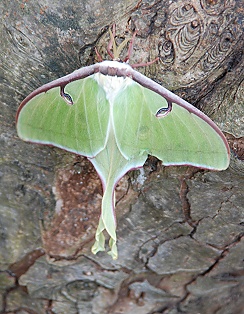
Luna Moth
The white “frosting” on the forewing purple stripe is (when really enlarged) white scales mixed with the purplish ones. You can just see the underwing eyespots showing through.
Read the rest of this entry »

Mar 07
Posted: under photography, Wildlife.
Tags: beauty, photography March 7th, 2009
Until today, I had never seen a Luna Moth. On the evening of my birthday, Richard found one clinging to a twig low under a rusty blackhaw viburnum. I rushed out with the camera. We think this moth had just emerged and begun the “stretching out” process, but we know very little about them. Richard […] [...more]
Until today, I had never seen a Luna Moth. On the evening of my birthday, Richard found one clinging to a twig low under a rusty blackhaw viburnum. I rushed out with the camera.
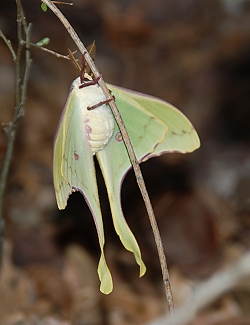
Luna Moth
We think this moth had just emerged and begun the “stretching out” process, but we know very little about them. Richard said they were fairly common in rural Alabama when he was a child, with “moth-watching parties” in the evenings.
Read the rest of this entry »

Feb 26
Posted: under photography, Plantlife, Wildlife.
Tags: Animal behavior, beauty, native plants, photography February 26th, 2009
Mexican plum, the tree-sized wild plum around here, blooms even in drought years. Not only is it snowy white and beautiful, it has that amazing wild-plum fragrance…and as it’s an early bloomer, it attracts everything that’s hungry for nectar. It doesn’t look like this long–especially in a drought year–and the tiny white petals are already […] [...more]
Mexican plum, the tree-sized wild plum around here, blooms even in drought years. Not only is it snowy white and beautiful, it has that amazing wild-plum fragrance…and as it’s an early bloomer, it attracts everything that’s hungry for nectar.
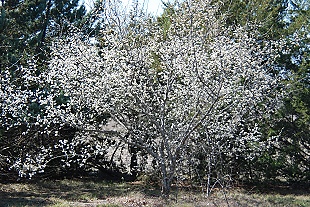
Mexican Plum in full bloom
It doesn’t look like this long–especially in a drought year–and the tiny white petals are already blowing off it in today’s stiff warm breeze.
Read the rest of this entry »

Feb 22
Posted: under photography, Wildlife.
Tags: observation, photography February 22nd, 2009
Even in a drought year, trees put out buds–at this time of year, the elms and hackberries and the early oaks may flower, and some of the migrant birds enjoy a lofty “salad” of buds from them. Here’s one of our taller elms showing golden-green lace against the blue sky. [...more]
Even in a drought year, trees put out buds–at this time of year, the elms and hackberries and the early oaks may flower, and some of the migrant birds enjoy a lofty “salad” of buds from them. Here’s one of our taller elms showing golden-green lace against the blue sky.
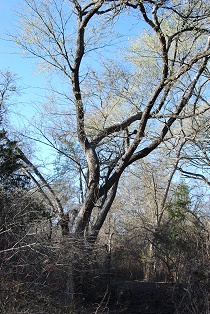
Early spring elm
Read the rest of this entry »













